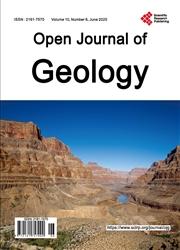Yampa River-Colorado River Drainage Divide Origin Determined from Topographic Map Evidence, Southern Routt County, Colorado, USA
引用次数: 3
Abstract
Detailed topographic map evidence and a new Cenozoic geologic and glacial history paradigm are used to determine the previously unexplained Yampa River-Colorado River drainage divide origin. The Yampa River now flows in a north direction away from the Colorado River (between the Park Range to the east and the Flat Tops region to the west) before turning in a west direction to reach the Unita Mountains where it joins the south-oriented Green River, which eventually joins the southwest-oriented Colorado River. Topographic maps show the Yampa-Colorado River drainage divide is asymmetric with steeper slopes leading to the Colorado River, barbed (south-oriented) tributaries leading to north-oriented Yampa River headwaters (especially near the Yampa River turn to the west), and evidence of a large north-to-south oriented diverging and converging channel complex that preceded present-day drainage routes. Map evidence is interpreted to mean massive south-oriented floods flowed through what are now north-oriented Yampa River headwaters valleys and that headward erosion of a deep west-oriented valley beheaded and reversed those south-oriented flood flow channels to create the north-oriented Yampa River headwaters and the Egeria Park area Yampa-Colorado River drainage divide seen today. Large south-oriented floods leading to the Colorado River (while regional uplift was occurring) are inconsistent with accepted Cenozoic geologic and glacial history paradigm predictions, but are predicted by a newly proposed Cenozoic geologic and glacial history paradigm in which a thick continental ice sheet created a deep “hole” by eroding underlying bedrock and also by causing crustal warping that raised the present-day northern Colorado east-west continental divide as immense south-oriented meltwater floods flowed across it.美国科罗拉多州南路特县,扬帕河-科罗拉多河流域分水岭起源的地形图证据
详细的地形图证据和新的新生代地质和冰川历史范式被用来确定之前无法解释的Yampa河-科罗拉多河流域分水岭的起源。Yampa河现在向北流动,远离科罗拉多河(位于东部的Park Range和西部的Flat Tops地区之间),然后向西转向,到达Unita山脉,在那里它与向南的Green河汇合,最终与西南方向的Colorado河汇合。地形图显示,亚姆帕-科罗拉多河的排水分水岭是不对称的,有更陡的斜坡通往科罗拉多河,有倒刺(向南)的支流通往向北的亚姆帕河源头(尤其是亚姆帕河西转弯附近),有证据表明,在当今的排水路线之前,有一个从北到南的大型分流和合流河道复合体。地图证据被解释为,大量向南的洪水流经现在向北的亚姆帕河源头山谷,而向西深处山谷的源头侵蚀切断并逆转了这些向南的洪水通道,形成了今天看到的向北的亚姆帕河源头和埃格里亚公园地区亚姆帕-科罗拉多河流域分水岭。导致科罗拉多河的大规模向南洪水(而区域隆起正在发生)与公认的新生代地质和冰川历史范式预测不一致,但这是由一种新提出的新生代地质和冰川史范式预测的,在该范式中,厚厚的大陆冰盖通过侵蚀下伏基岩,并导致地壳翘曲,形成了一个深“洞”,随着巨大的向南融水洪水流过,导致了如今科罗拉多州北部的东西大陆分水岭。
本文章由计算机程序翻译,如有差异,请以英文原文为准。
求助全文
约1分钟内获得全文
求助全文

 求助内容:
求助内容: 应助结果提醒方式:
应助结果提醒方式:


